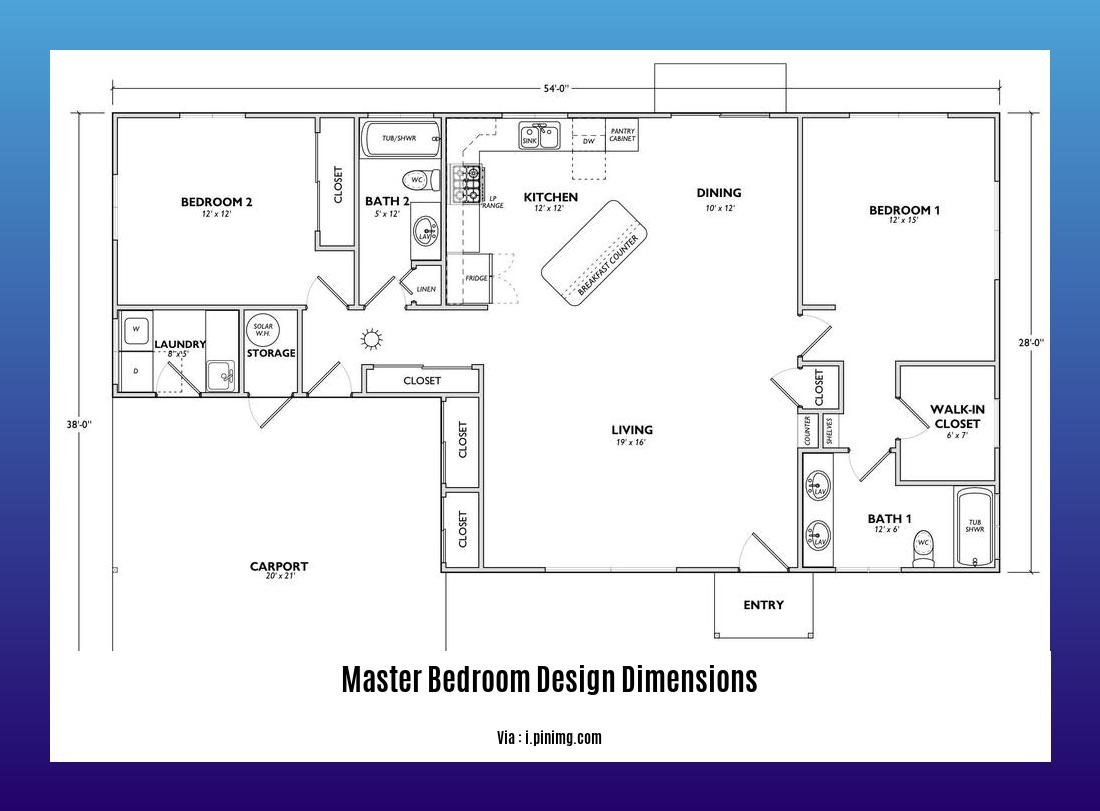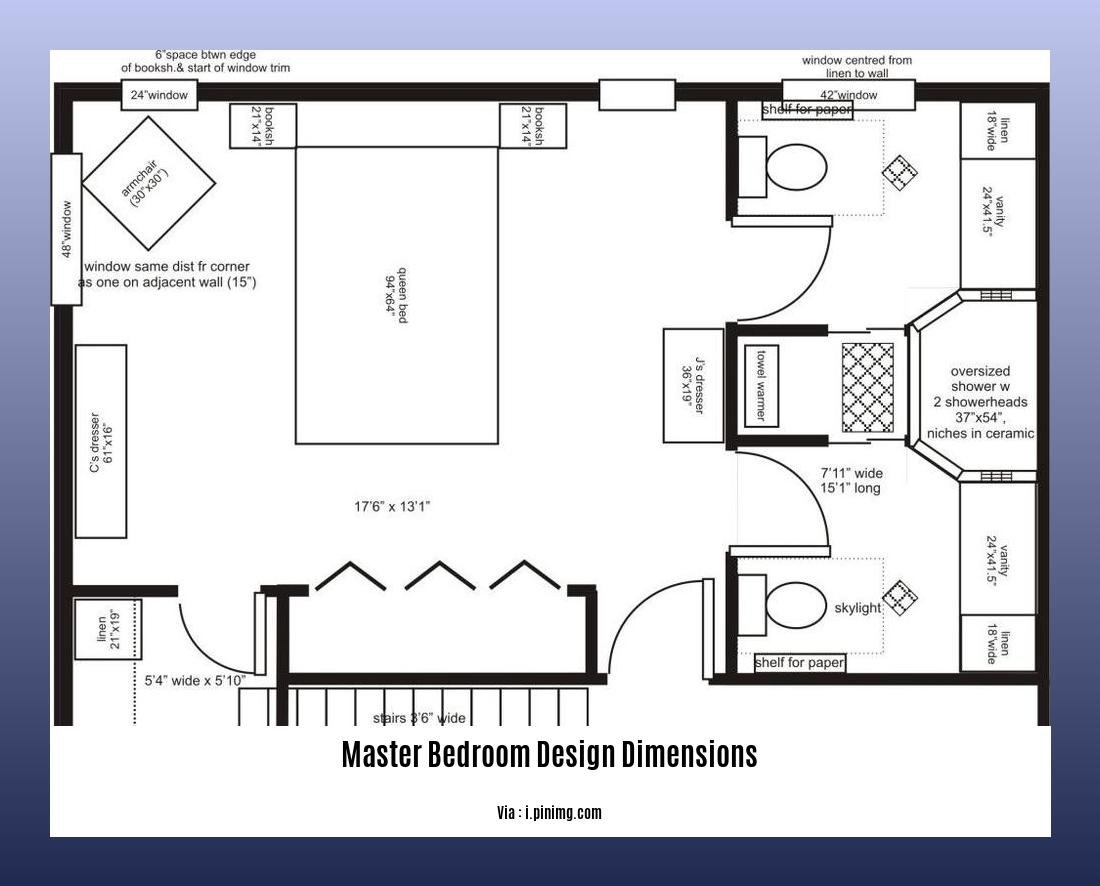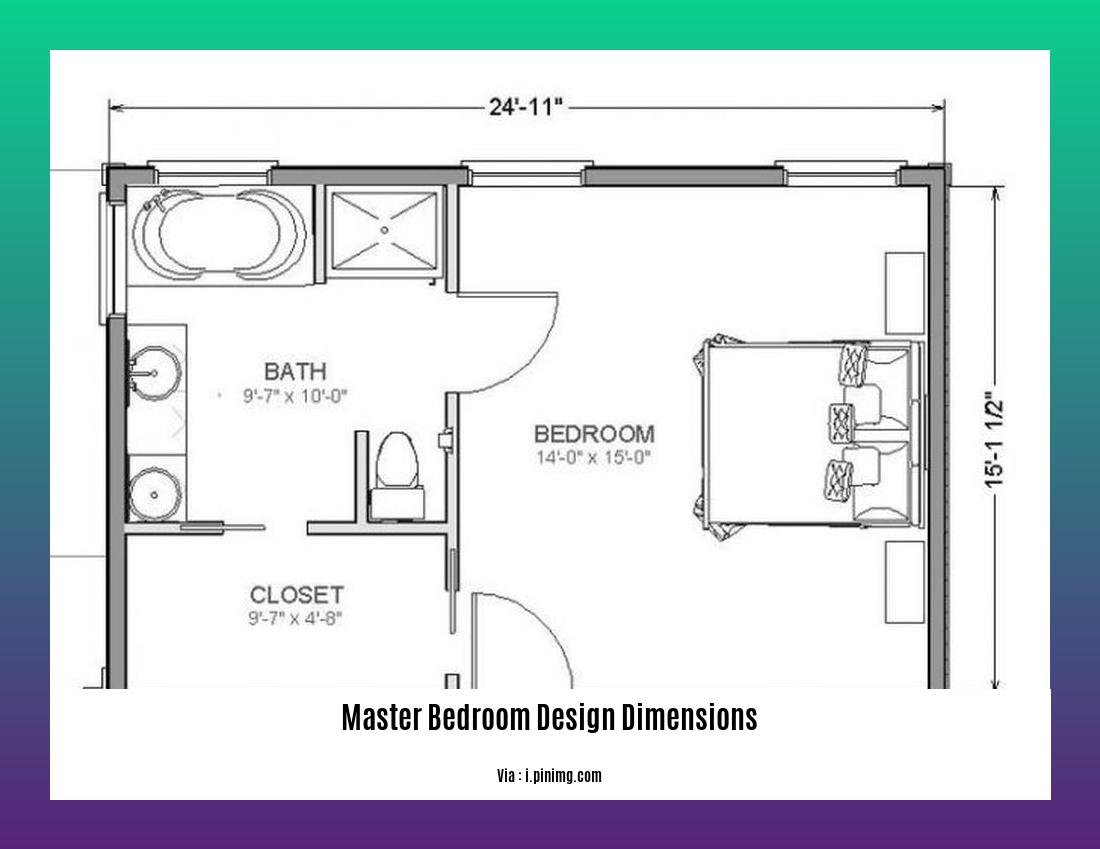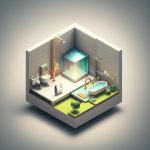When it comes to creating a master bedroom that is both a sanctuary and a reflection of your personal style, the dimensions of the space are crucial. In this article, we will explore the art of master bedroom design dimensions, focusing on how proper space utilization, strategic lighting choices, and thoughtful furniture placement can transform a simple room into a perfect sanctuary. Whether you are looking to create a cozy retreat or an elegant haven, mastering the art of master bedroom design dimensions will be the key to achieving the perfect balance of comfort and style.
Key Takeaways:
- The dimensions of a master bedroom can range from 16 x 22 to 20 x 20 feet or 4.8 x 6.7 to 6 x 6 meters.
- In houses larger than 3,000 square feet, the master bedroom size can be between 350 to 420 square feet or 33 to 39 square meters.
- The size of a master bedroom depends on the home’s existing footprint or the homeowner’s construction plans.
- Smaller homes typically have master suites that are about 231 square feet or 21 square meters.
- Larger homes can have master bedrooms reaching up to 411 square feet or 38 square meters, or becoming multi-room suites.
- Guest rooms usually have a standard size of 10 x 12 feet or 3 x 3.7 meters.
- Children’s rooms typically have a standard size of 10 x 10 feet or 3 x 3 meters.
- The door size of a standard bedroom should be at least 7 feet or 2.1 meters in height, with a width of 3-4 feet or 0.9-1.2 meters.
Master Bedroom Design Dimensions

When it comes to designing the dimensions of a master bedroom, there are several factors to consider. From the size of the room to the placement of furniture, every element plays a crucial role in creating a comfortable and functional space. In this instructional guide, we will explore the key considerations and guidelines for designing the dimensions of a master bedroom effectively. So, let’s dive in and create the perfect sanctuary with space, lighting, and furniture placement!
Determining the Size
One of the first and most important aspects of designing a master bedroom is determining its size. The dimensions of a master bedroom can vary depending on various factors, such as the size of the house and the homeowner’s preferences. Common master bedroom sizes range from 16 x 22 to 20 x 20 feet or 4.8 x 6.7 to 6 x 6 meters. For larger houses of more than 3,000 square feet (or 279 square meters), the master bedroom size can be between 350 to 420 square feet (or 33 to 39 square meters). On the other hand, in smaller homes, the average size of a master suite is about 231 square feet (or 21 square meters). It’s important to consider the existing footprint of the home or the plans for construction when determining the size of the master bedroom.
Layout Considerations
Once you have determined the size of the master bedroom, it’s essential to consider the layout. The placement of windows, doors, and furniture greatly impacts the functionality and aesthetics of the room. To create a harmonious design, ensure that the door size of the master bedroom is at least 7 feet (or 2.1 meters) in height, with a width of 3-4 feet (or 0.9-1.2 meters). This ensures easy access and a grand entrance to the room.
When it comes to furniture placement, it’s crucial to strike a balance between functionality and aesthetics. Consider the focal point of the room, which is typically the bed, and arrange other furniture pieces such as dressers, nightstands, and seating areas accordingly. Keep in mind the flow of the room and leave enough space for comfortable movement. Remember, a clutter-free and well-organized layout contributes to a serene and peaceful atmosphere.
Lighting Solutions
Proper lighting plays a vital role in creating the perfect ambiance in a master bedroom. It’s important to consider both natural and artificial lighting sources. Natural light not only enhances the overall mood of the room but also provides health benefits. Large windows or strategically placed skylights can bring in ample natural light, creating a refreshing and inviting atmosphere. However, it’s also necessary to have
adequate privacy and light control options for nighttime.
In addition to natural light, incorporate a variety of artificial lighting sources to provide flexibility and control over the room’s ambiance. Consider using a combination of overhead lights, task lights, and ambient lighting. Dimmer switches can add versatility and allow you to adjust the lighting intensity according to your preferences and mood.
Achieving Optimal Comfort
The dimensions of a master bedroom are not solely determined by its size and layout. It’s also crucial to consider elements that contribute to the overall comfort of the space. Pay attention to factors such as ventilation, insulation, and acoustics. Proper ventilation ensures a fresh and healthy environment, while insulation helps regulate the room’s temperature and reduces noise intrusion. Additionally, incorporating soundproofing elements such as thick curtains or wall panels can create a tranquil and peaceful atmosphere essential for restful sleep.
Conclusion
Designing the dimensions of a master bedroom requires careful consideration of various aspects, from size and layout to lighting and comfort. By understanding the guidelines and considering the unique requirements of your space, you can create a master bedroom that provides the perfect sanctuary within your home. Remember, each element contributes to the overall harmony and functionality of the room, allowing you to enjoy a comfortable and aesthetically pleasing space for years to come. So, go ahead and transform your master bedroom into a haven of relaxation and serenity!
Looking for stylish and convenient bedroom reading lights that can be easily mounted on your wall in New Zealand? Check out our selection of Bedroom reading lights wall mounted NZ at ../bedroom-reading-lights-wall-mounted-nz for the perfect lighting solution.
Browse through an extensive range of Bedroom set furniture options available online and elevate the look of your bedroom. Explore our collection at ../bedroom-set-furniture-online and find the perfect furniture pieces to create your dream bedroom setup.
Stay updated with the latest trends in bedroom interior design in Pakistan with our stunning collection of Latest bedroom furniture designs in Pakistan. Discover the most stylish and contemporary designs at ../latest-bedroom-furniture-designs-in-pakistan and transform your bedroom into a haven of comfort and elegance.
Ideal layouts for different master bedroom dimensions

Designing the dimensions of a master bedroom requires careful consideration to ensure functionality and aesthetic appeal. Whether you have a spacious room or a smaller area to work with, optimizing the layout is key to creating the perfect sanctuary. In this article, we will explore ideal layouts for different master bedroom dimensions, providing practical tips and guidelines to help you design your dream space.
Standard Size and Layout
When determining the size of a master bedroom, it’s essential to consider personal preferences and the size of your home. While the ideal size can vary, a commonly followed standard is a minimum of 225 square feet or about 15 by 15 feet[^1^]. This size allows for a comfortable arrangement of a king-sized bed and additional furniture items.
The layout of the room also plays a significant role in determining the size of your master bedroom. Factors such as walk-in closets, ensuite bathrooms, or lounge areas should be incorporated into the design process, as they contribute to the overall dimensions of the space.
Design Considerations
To create a comfortable and functional master bedroom, several design considerations should be kept in mind. These include:
-
Furniture Placement: Adequate space should be allocated for furniture placement, allowing for easy movement and access. Consider the best positioning for your bed, nightstands, dressers, and other furniture pieces to create a balanced and visually appealing layout.
-
Storage Solutions: Incorporating storage options such as built-in closets, dressers, or shelving units is crucial in maximizing space and keeping your bedroom organized. Evaluate your storage needs and explore creative solutions to make the most of your available space.
-
Lighting: Proper lighting is essential in setting the ambiance of your master bedroom. Incorporate a mix of natural light, overhead lighting, and task lighting to create different lighting levels for various purposes. Think about the placement of windows, light fixtures, and consider installing dimmer switches for added flexibility.
-
Color Palette: The chosen color palette greatly impacts the perceived size and atmosphere of a master bedroom. Lighter colors tend to create an illusion of more space, while darker shades can add coziness and warmth. Select colors that align with your preferred style and create the desired mood for your sanctuary.
-
Privacy and Noise Control: Enhancing privacy and creating a peaceful environment in your master bedroom can greatly contribute to your overall comfort. Consider incorporating features such as soundproofing, window treatments, and door locks to create a serene and secure space.
Small Master Bedroom Designs
Not all master bedrooms have ample space to work with. If you have a smaller master bedroom, ranging from 120 to 224 square feet, thoughtful design is even more critical[^2^]. Consider the following tips to maximize functionality in a limited space:
-
Scale Down Furniture: Opt for smaller-sized furniture pieces to ensure they fit well within the limited space without overwhelming the room. Look for space-saving options such as platform beds or compact dressers.
-
Multifunctional Furniture: Make the most of your space by choosing furniture items that serve multiple purposes. Storage beds, bedside tables with built-in drawers, or ottomans with hidden storage compartments are excellent choices for small master bedrooms.
-
Mirrors and Lighting: Strategically placed mirrors can create an illusion of added space in a small master bedroom. Additionally, well-placed lighting can brighten up the room and make it appear larger. Consider utilizing mirrors and incorporating natural and artificial light sources to optimize your space.
-
Smart Storage Solutions: Utilize every inch of available storage space in a small master bedroom. Explore under-bed storage options, vertical wall shelves, and organizers to maximize storage capacity without compromising on style and aesthetics.
These design considerations and tips can help you transform even a small master bedroom into a cozy and inviting space that meets your needs and preferences.
Key Takeaways:
- The ideal size for a master bedroom is a minimum of 225 square feet or about 15 by 15 feet, allowing for comfortable furniture placement.
- Consider the layout of the room, incorporating additional features like walk-in closets and ensuite bathrooms.
- When designing a master bedroom, think about furniture placement, storage solutions, lighting, color palette, and privacy.
- In small master bedroom designs, opt for smaller furniture pieces, utilize multifunctional furniture, strategically use mirrors and lighting, and make the most of smart storage solutions.
References:
[^1^]: Master Bedroom Size (Dimensions Guide) – Designing Idea
[^2^]: Master Bedroom Size – Knock Off Decor
Tips for Maximizing Space in a Small Master Bedroom
Small bedrooms can present a challenge when it comes to creating a functional and comfortable living space. However, with some clever ploys, you can maximize the available space and make the most of every inch in a small master bedroom. Here are some tips to help you create a spacious and organized sanctuary:
-
Clear the clutter and opt for minimalism: Removing unnecessary items and embracing a minimalist approach can instantly create a sense of spaciousness in a small master bedroom.
-
Choose tall and slim over short and wide: When selecting furniture, opt for tall and slim pieces rather than short and wide ones. This will help maximize vertical space and make the room feel more open.
-
Max out your wall space: Utilize the walls by installing shelves, hooks, or a pegboard to store and display items. This will free up valuable floor space and keep the room organized.
-
Employ a creative joiner for custom storage: Consider hiring a joiner who can create custom storage solutions tailored to the specific dimensions of your bedroom. This will help maximize storage space and keep belongings neatly organized.
-
Opt for a side table with a slim profile: Instead of bulky bedside tables, choose a slim-profile side table or a wall-mounted shelf to save space and maintain a streamlined look.
-
Invest in wardrobes that reach the ceiling: To maximize storage in a small bedroom, invest in wardrobes that reach the ceiling. This will utilize the vertical space and provide ample storage for clothing and other belongings.
-
Hide clutter in a bespoke alcove: Consider creating a bespoke alcove in the bedroom where you can hide clutter such as laundry baskets or storage boxes. This will help keep the room tidy and free up floor space.
-
Position the bed for maximum floor space: Consider placing the bed in a strategic position that allows for maximum floor space. This could involve placing it against a wall or in a corner to create more open space in the room.
By implementing these clever ploys, you can greatly maximize space in a small master bedroom and create a more functional and comfortable living environment.
Key Takeaways:
- Clearing the clutter and embracing minimalism creates a sense of spaciousness.
- Opt for tall and slim furniture to maximize vertical space.
- Utilize wall space with shelves, hooks, or a pegboard for storage.
- Consider custom storage solutions tailored to the dimensions of your bedroom.
- Choose a slim-profile side table or wall-mounted shelf to save space.
- Invest in wardrobes that reach the ceiling for maximum storage.
- Create a bespoke alcove to hide clutter and free up floor space.
- Position the bed strategically to maximize floor space.
Sources:
1. Homes & Gardens – How to maximize space in a small bedroom: 10 clever ploys
2. Real Homes – 13 ways to maximize space in a small bedroom
Trends in Master Bedroom Design Dimensions: Creating the Perfect Sanctuary for 2023
Designing the dimensions of a master bedroom is an important consideration for creating a comfortable and aesthetically pleasing sanctuary. In this article, we will explore the latest trends in master bedroom design dimensions for 2023 and provide expert guidance on achieving the perfect balance of space, lighting, and furniture placement.
Key Takeaways:
– The ideal size of a master bedroom can range from 110 square feet to 400+ square feet, allowing for personal preferences and home size[^1^].
– Sustainable luxury and nature-inspired palettes are popular trends in master bedroom design for 2023[^2^].
– Texture is taking center stage in bedroom design, with textured walls being a popular choice[^2^].
– Canopy beds have made a comeback in 2023, adding elegance and a luxurious touch to master bedrooms[^2^].
– Mixing and matching furniture is preferred over matching bedroom sets, allowing for personalized style and creativity[^2^].
– Incorporating greenery and biophilic design elements, such as plants like snake plants, peace lilies, and pothos, is a trend in master bedroom design for 2023[^2^].
When designing the size and layout of a master bedroom, it’s important to consider both functional and aesthetic aspects. The standard size of a master bedroom is commonly 225 square feet or about 15 by 15 feet, providing enough space for a king bed and additional furniture items[^1^]. However, personal preferences and the inclusion of features like walk-in closets, ensuite bathrooms, or lounge areas may require adjustments to the dimensions.
To maximize the functionality and comfort of a master bedroom, here are some essential design considerations to keep in mind:
-
Furniture Placement: Allocating adequate space for furniture placement ensures easy movement and access. Consider the flow of the room and arrange furniture in a way that optimizes space and functionality.
-
Proper Lighting: Lighting plays a crucial role in setting the ambiance of a master bedroom. Incorporate a mix of natural light, overhead lighting, and task lighting. Consider utilizing dimmers for adjustable lighting options.
-
Color Palette: Choose a color palette that reflects the desired atmosphere of the master bedroom. Nature-inspired palettes, including serene greens, warm earth tones, or calming neutrals, are popular choices for 2023.
-
Texture and Wall Treatments: Embrace the trend of textured walls to add depth and interest to the master bedroom. Consider using materials such as textured wallpaper, reclaimed wood paneling, or decorative wall tiles.
-
Storage Solutions: Incorporate smart storage solutions to maximize space and keep the bedroom organized. Built-in closets, under-bed storage, and multi-functional furniture can help declutter the space.
-
Privacy and Noise Control: Enhance privacy and create a peaceful environment by incorporating features like soundproofing, window treatments, and door locks.
For those with smaller master bedrooms, making the most of limited space is key. Here are some tips for designing a small master bedroom:
-
Scale Down Furniture: Opt for smaller-sized furniture pieces to fit well within the limited space without overwhelming the room.
-
Multifunctional Furniture: Choose furniture items that serve multiple purposes, such as storage beds or bedside tables with built-in drawers.
-
Mirrors and Lighting: Strategically placed mirrors can create an illusion of added space. Well-placed lighting can brighten up the room and make it appear larger.
-
Smart Storage Solutions: Utilize under-bed storage, vertical wall shelving, and organizers to maximize limited storage space.
In conclusion, the size and dimensions of a master bedroom greatly impact its overall design and functionality. By considering the latest trends and incorporating expert design principles, you can create your perfect sanctuary. Remember to prioritize space, lighting, and furniture placement in line with your personal taste and lifestyle preferences. With the right dimensions and design choices, your master bedroom can be transformed into a comfortable and aesthetically pleasing retreat.
References:
[^1^]: Upgraded Home: Master Bedroom Dimensions & Layout Guidelines
[^2^]: Melanie Jade Design: Master Bedroom Trends 2023: What’s Hot in Bedroom Design
FAQ
Q1: What is the recommended size for a master bedroom?
A1: The ideal size for a master bedroom can vary, but a commonly followed standard is a minimum of 225 square feet or about 15 by 15 feet. This size provides enough space to accommodate a king bed and additional smaller furniture items.
Q2: How can I maximize space in a small master bedroom?
A2: To maximize space in a small master bedroom, consider opting for minimalism and removing unnecessary items. Choose tall and slim furniture pieces to maximize vertical space, utilize wall space for shelving and storage, and invest in custom storage solutions. Additionally, consider a slim-profile side table or a wall-mounted shelf instead of bulky bedside tables.
Q3: What are some important design considerations for a master bedroom?
A3: When designing a master bedroom, important considerations include furniture placement to allow for easy movement and access, incorporating storage solutions to maximize space and organization, selecting the right lighting for ambiance, choosing a color palette that suits the desired atmosphere, and incorporating features to enhance privacy and control noise.
Q4: What are some tips for designing a small master bedroom?
A4: For designing a small master bedroom, consider scaling down furniture and opting for multifunctional furniture pieces. Strategically placed mirrors can create an illusion of added space, while smart storage solutions like under-bed storage and wall shelving can maximize storage space. Additionally, utilizing a light color palette can make the room feel larger.
Q5: Can a master bedroom incorporate additional features like ensuite bathrooms or walk-in closets?
A5: Yes, a master bedroom can incorporate additional features like ensuite bathrooms, walk-in closets, or even a lounge area on a terrace. The size of the master bedroom should be determined based on personal preferences and the desired layout incorporating these additional elements.
- Backsplash For Gray Cabinets: Choosing the Right Backsplash Style - December 13, 2025
- Gray And White Backsplash: Ideas For Timeless Style - December 12, 2025
- Gray Kitchen Backsplash Ideas: Find Your Perfect Gray Tile - December 11, 2025









